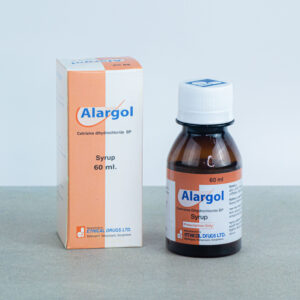ED-FEX® – Fexofenadine Hydrochloride USP
COMPOSITION
Available in two dosage forms
120 Tablet: Each film coated tablet contains Fexofenadine Hydrochloride USP 120 mg.
180 Tablet: Each film coated tablet contains Fexofenadine Hydrochloride USP 180 mg.
Suspension: Each 5 ml suspension contains Fexofenadine Hydrochloride USP 30 mg.
PHARMACOLOGY
Fexofenadine Hydrochloride is a non-sedative antihistamine with selective peripheral H1-receptor antagonist activity which inhibits histamine release from peritoneal mast cells. Fexofenadine is rapidly absorbed after oral doses with peak plasma concentrations being reached in 2-3 hours. It is about 60 to 70% bound to plasma proteins. About 5% of the total dose is metabolized, mostly by the intestinal mucosa and by the cytochrome P450 system. Elimination half life is 14 hours. Excretion is mainly in the faces with only 10% being present in the urine. Fexofenadine does not appear to cross the blood-brain barrier.
INDICATION
Fexofenadine is indicated in seasonal allergic rhinitis & chronic idiopathic urticaria in adults and children (6 months & older). Symptoms treated effectively are sneezing, rhinorrhea, itchy nose/throat, itchy/watery/red eyes. It also significantly reduces pruritus and the number of wheals & flare.
DOSAGE & ADMINISTRATION
Adults and Children 12 years & Older: The recommended dose of Fexofenadine is 120 mg or 180 mg once daily. A dose of 60 mg once daily is recommended as the starting dose in patients with decreased renal function.
Children between 2 to 11 years: The recommended dose of Fexofenadine is 30mg twice daily. A dose of 30 mg (5 ml) once daily is recommended as the starting dose in pediatric patients with decreased renal function.
Children between 6 months to less than 2 years: The recommended dose of Fexofenadine is 15 mg twice daily. A dose of 15 mg (2.5 ml) once daily is recommended as the starting dose in pediatric patients with decreased renal function.
SIDE EFFECT
The most common side effects are headache, nausea, dizziness, drowsiness and sleepiness, nervousness and frequent coughing are seen in less than 1% of patients.
PRECAUTION
Fexofenadine should be used with caution in patients with liver and kidney problems (especially children); patients with a history of or on going heart diseases.
CONTRAINDICATION
Fexofenadine is contraindicated in patients with known hypersensitivity to any of its ingredients.
DRUG INTERACTION
Plasma concentrations of Fexofenadine have been increased when given with Erythromycin or Ketoconazole. Antacid containing Aluminium and Magnesium Hydroxide reduces the absorption of Fexofenadine.
USE IN PREGNANCY & LACTATION
There are no adequate and well controlled studies in pregnant women. Fexofenadine should be used during pregnancy only if the potential benefit justifies the potential risk to the fetus.
It is not known whether Fexofenadine is excreted in human milk or not. Caution should be exercised when Fexofenadine is administered to a nursing women.
OVERDOSE
Taking too much Fexofenadine may cause the following: dizziness, drowsiness, fatigue and dry mouth.
STORAGE
Store tablet and suspension at or below 30°C. Protect from light & moisture. Keep out of the reach of children.
PACKAGING
ED-FEX® 120 Tablet: Each box contains 3 x 10’s tablets in Alu-Alu blister pack.
ED-FEX® 180 Tablet: Each box contains 3 x 10’s tablets in Alu-Alu blister pack.
ED-FEX® Suspension: Each bottle contains 50 ml suspension.









